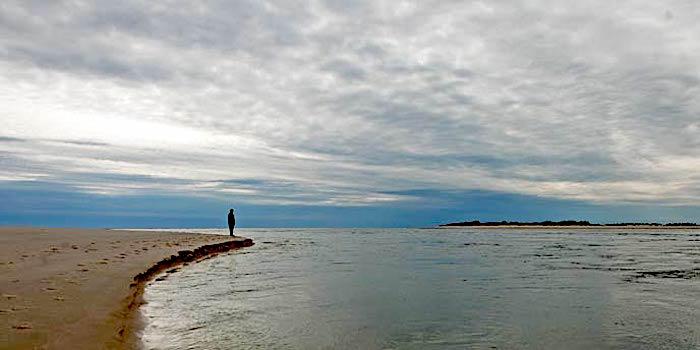
Public comments on how to deal with a breach in the Otis Pike Fire Island Wilderness range from calls to close the breach to keeping it open/NPS
To fill the breach, or broaden the breach, those are some of the questions being raised at Fire Island National Seashore in New York, where officials are developing a management plan for a breach Hurricane Sandy drilled in the Otis Pike Fire Island High Dune Wilderness Area back in 2012.
While two other breaches caused by the potent storm were filled mechanically by response teams, the one through the wilderness area has remained open to the whims of the Atlantic. The Breach Management Plan and Environmental Impact Statement being prepared by the seashore staff is to determine how best to manage the breach.
In seeking comment on what should be considered during development of this plan, the seashore received more than 350 comments that ranged from calls to leave the breach open and to close it as well as more 'creative' approaches for managing the situation. Far and away the bulk of the comments -- 154 -- suggested the breach remain open and left to the Atlantic's currents. Some suggested ongoing dredging to ensure it remains open.
"This season we have experienced cleaner bay waters than we have seen in years. The species of fish has grown and multiplied, ravishing our bay with plentiful wildlife. The shoreline has prospered with growth of eel grass, which has helped the clam beds to repopulate," wrote one respondent. "My desired outcome would be to dredge the breach and create an inlet. I live close to the bay, within 60 feet, and I have not experienced any flooding beyond the norm. In fact, the low tide is lower than normal. At the very least, preserve what nature has created again and leave it as it stands currently."
Another commenter, though, urged the National Park Service to close the breach.
"The area around the breach is narrow and susceptible to another breach. Closing and building a dune and beach great enough to offer reasonable protection from another storm once the breach is closed is paramount," they wrote. "If you just close it this will happen again in short order. A simple close does not put this issue to rest."
Others thought the Park Service should keep the breach open, but stabilize it, and make the area accessible to boaters.
"Instead of thinking on spending millions on trying to close it, spend one third dredging, stabilizing its banks, and create an area where people can access without trespassing and damaging what nature has given us," they wrote. "Dredge, mark correctly with buoys, and dedicate a area for boaters to access the beach and stay within the area, then you can ticket if trespassing."

The breach has been altered by the whims of the Atlantic Ocean's currents/NPS
And then there were those who voiced somewhat creative thoughts for a lock system that could be opened and closed, depending on storm conditions, yet still have a system in place to enable mixing of ocean and Great South Bay waters.
"Rather then permanently closing it, perhaps some type of lock system could be put in place. It could then be opened during calm weather and closed during storms," the writer suggested. "We should engineer and build additional ways for ocean water and bay water to mix. Either a man-made inlet, some type of underground pipe that goes under Fire Island for bay/ocean water exchange, or a lock system at one or two points that could be opened and closed as needed. The area between Water Island and the Pines looks like a good place to consider."
Another commenter also voiced support for "several sluice pipes ... placed underneath Fire Island at critical points to keep the bay flushed properly."
Finally, some wondered why the Park Service was even considering a management plan for the breach.
"My concern is that NPS/FINS even has a breach management plan. It's in a designated wilderness area, the breach is a natural function, poses no threat to property or infrastructure, and provides tremendous benefit to the bay," they wrote. "There are much better ways to spend public time and resources where the environment of Fire Island and Great South Bay is concerned. Short of leaving the new inlet alone, it could be 'managed' ... Let it close up naturally if that's what it wants to do, but open it manually to help the health of the bay seasonally/occasionally."
Seashore officials hope to have a draft of the management plan available later this summer for public review and comment.



Add comment